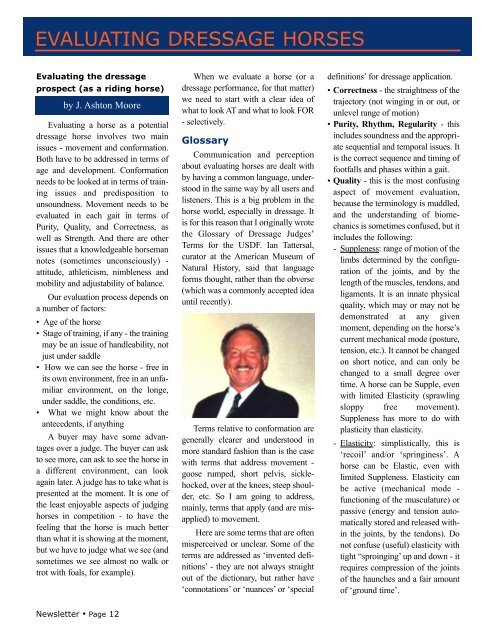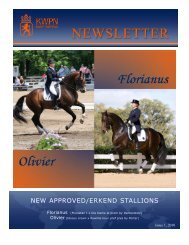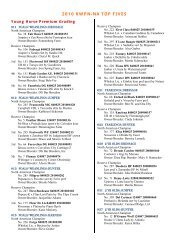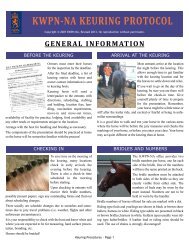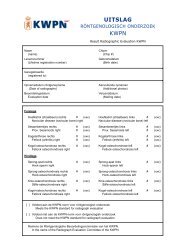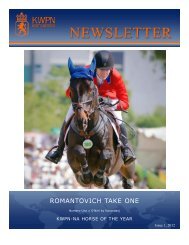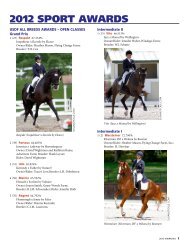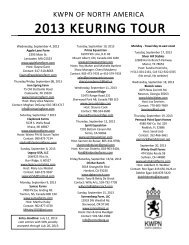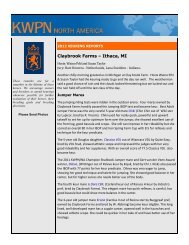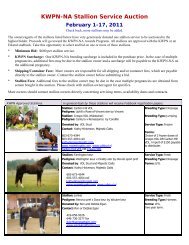Download PDF - KWPN
Download PDF - KWPN
Download PDF - KWPN
Create successful ePaper yourself
Turn your PDF publications into a flip-book with our unique Google optimized e-Paper software.
EVALUATING DRESSAGE HORSES<br />
Evaluating the dressage<br />
prospect (as a riding horse)<br />
by J. Ashton Moore<br />
Evaluating a horse as a potential<br />
dressage horse involves two main<br />
issues - movement and conformation.<br />
Both have to be addressed in terms of<br />
age and development. Conformation<br />
needs to be looked at in terms of training<br />
issues and predisposition to<br />
unsoundness. Movement needs to be<br />
evaluated in each gait in terms of<br />
Purity, Quality, and Correctness, as<br />
well as Strength. And there are other<br />
issues that a knowledgeable horseman<br />
notes (sometimes unconsciously) -<br />
attitude, athleticism, nimbleness and<br />
mobility and adjustability of balance.<br />
Our evaluation process depends on<br />
a number of factors:<br />
• Age of the horse<br />
• Stage of training, if any - the training<br />
may be an issue of handleability, not<br />
just under saddle<br />
• How we can see the horse - free in<br />
its own environment, free in an unfamiliar<br />
environment, on the longe,<br />
under saddle, the conditions, etc.<br />
• What we might know about the<br />
antecedents, if anything<br />
A buyer may have some advantages<br />
over a judge. The buyer can ask<br />
to see more, can ask to see the horse in<br />
a different environment, can look<br />
again later. A judge has to take what is<br />
presented at the moment. It is one of<br />
the least enjoyable aspects of judging<br />
horses in competition - to have the<br />
feeling that the horse is much better<br />
than what it is showing at the moment,<br />
but we have to judge what we see (and<br />
sometimes we see almost no walk or<br />
trot with foals, for example).<br />
When we evaluate a horse (or a<br />
dressage performance, for that matter)<br />
we need to start with a clear idea of<br />
what to look AT and what to look FOR<br />
- selectively.<br />
Glossary<br />
Communication and perception<br />
about evaluating horses are dealt with<br />
by having a common language, understood<br />
in the same way by all users and<br />
listeners. This is a big problem in the<br />
horse world, especially in dressage. It<br />
is for this reason that I originally wrote<br />
the Glossary of Dressage Judges’<br />
Terms for the USDF. Ian Tattersal,<br />
curator at the American Museum of<br />
Natural History, said that language<br />
forms thought, rather than the obverse<br />
(which was a commonly accepted idea<br />
until recently).<br />
Terms relative to conformation are<br />
generally clearer and understood in<br />
more standard fashion than is the case<br />
with terms that address movement -<br />
goose rumped, short pelvis, sicklehocked,<br />
over at the knees, steep shoulder,<br />
etc. So I am going to address,<br />
mainly, terms that apply (and are misapplied)<br />
to movement.<br />
Here are some terms that are often<br />
misperceived or unclear. Some of the<br />
terms are addressed as ‘invented definitions’<br />
- they are not always straight<br />
out of the dictionary, but rather have<br />
‘connotations’ or ‘nuances’ or ‘special<br />
definitions’ for dressage application.<br />
• Correctness - the straightness of the<br />
trajectory (not winging in or out, or<br />
unlevel range of motion)<br />
• Purity, Rhythm, Regularity - this<br />
includes soundness and the appropriate<br />
sequential and temporal issues. It<br />
is the correct sequence and timing of<br />
footfalls and phases within a gait.<br />
• Quality - this is the most confusing<br />
aspect of movement evaluation,<br />
because the terminology is muddled,<br />
and the understanding of biomechanics<br />
is sometimes confused, but it<br />
includes the following:<br />
-Suppleness: range of motion of the<br />
limbs determined by the configuration<br />
of the joints, and by the<br />
length of the muscles, tendons, and<br />
ligaments. It is an innate physical<br />
quality, which may or may not be<br />
demonstrated at any given<br />
moment, depending on the horse’s<br />
current mechanical mode (posture,<br />
tension, etc.). It cannot be changed<br />
on short notice, and can only be<br />
changed to a small degree over<br />
time. A horse can be Supple, even<br />
with limited Elasticity (sprawling<br />
sloppy free movement).<br />
Suppleness has more to do with<br />
plasticity than elasticity.<br />
-Elasticity: simplistically, this is<br />
‘recoil’ and/or ‘springiness’. A<br />
horse can be Elastic, even with<br />
limited Suppleness. Elasticity can<br />
be active (mechanical mode -<br />
functioning of the musculature) or<br />
passive (energy and tension automatically<br />
stored and released within<br />
the joints, by the tendons). Do<br />
not confuse (useful) elasticity with<br />
tight “sproinging’ up and down - it<br />
requires compression of the joints<br />
of the haunches and a fair amount<br />
of ‘ground time’.<br />
Newsletter • Page 12


